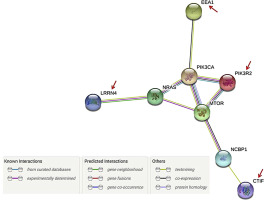当前位置:
X-MOL 学术
›
J. Food Drug Anal.
›
论文详情
Our official English website, www.x-mol.net, welcomes your
feedback! (Note: you will need to create a separate account there.)
Reduction of aluminum ion neurotoxicity through a small peptide application – NAP treatment of Alzheimer's disease
Journal of Food and Drug Analysis ( IF 2.6 ) Pub Date : 2019-04-01 , DOI: 10.1016/j.jfda.2018.11.009 Ming-Hui Yang , Shih-Cheng Chen , Yu-Fen Lin , Yi-Chia Lee , Ming-Yii Huang , Ko-Chin Chen , Hsin-Yi Wu , Po-Chiao Lin , Illana Gozes , Yu-Chang Tyan
Journal of Food and Drug Analysis ( IF 2.6 ) Pub Date : 2019-04-01 , DOI: 10.1016/j.jfda.2018.11.009 Ming-Hui Yang , Shih-Cheng Chen , Yu-Fen Lin , Yi-Chia Lee , Ming-Yii Huang , Ko-Chin Chen , Hsin-Yi Wu , Po-Chiao Lin , Illana Gozes , Yu-Chang Tyan

|
Alzheimer's disease (AD) is the most common cause of dementia in late life. It is difficult to precisely diagnose AD at early stages, making biomarker search essential for further developments. The objective of this study was to identify protein biomarkers associated with aluminum ions toxicity (AD-like toxicity) in a human neuroblastoma cell model, SH-SY5Y and assess potential prevention by NAP (NAPVSIPQ). Complete proteomic techniques were implemented. Four proteins were identified as up-regulated with aluminum ion treatment, CBP80/20-dependent translation initiation factor (CTIF), Early endosome antigen 1 (EEA1), Leucine-rich repeat neuronal protein 4 (LRRN4) and Phosphatidylinositol 3-kinase regulatory subunit beta (PI3KR2). Of these four proteins, EEA1 and PI3KR2 were down-regulated after NAP-induced neuroprotective activity in neuroblastoma cells. Thus, aluminum ions may increase the risk for neurotoxicity in AD, and the use of NAP is suggested as a treatment to provide additional protection against the effects of aluminum ions, via EEA1 and PI3KR2, associated with sorting and processing of the AD amyloid precursor protein (APP) through the endosomal system.
中文翻译:

通过小肽应用降低铝离子神经毒性——阿尔茨海默病的 NAP 治疗
阿尔茨海默病 (AD) 是老年痴呆症的最常见原因。在早期阶段难以准确诊断 AD,因此生物标志物搜索对于进一步发展至关重要。本研究的目的是在人神经母细胞瘤细胞模型 SH-SY5Y 中鉴定与铝离子毒性(AD 样毒性)相关的蛋白质生物标志物,并评估 NAP (NAPVSIPQ) 的潜在预防作用。实施了完整的蛋白质组学技术。四种蛋白质被鉴定为用铝离子处理、CBP80/20 依赖性翻译起始因子 (CTIF)、早期内体抗原 1 (EEA1)、富含亮氨酸的重复神经元蛋白 4 (LRRN4) 和磷脂酰肌醇 3-激酶调节亚基上调β (PI3KR2)。在这四种蛋白质中,在 NAP 诱导的神经母细胞瘤细胞中的神经保护活性后,EEA1 和 PI3KR2 被下调。因此,铝离子可能会增加 AD 中神经毒性的风险,建议使用 NAP 作为一种治疗方法,通过 EEA1 和 PI3KR2 对铝离子的影响提供额外的保护,与 AD 淀粉样前体蛋白的分选和加工有关(APP) 通过内体系统。
更新日期:2019-04-01
中文翻译:

通过小肽应用降低铝离子神经毒性——阿尔茨海默病的 NAP 治疗
阿尔茨海默病 (AD) 是老年痴呆症的最常见原因。在早期阶段难以准确诊断 AD,因此生物标志物搜索对于进一步发展至关重要。本研究的目的是在人神经母细胞瘤细胞模型 SH-SY5Y 中鉴定与铝离子毒性(AD 样毒性)相关的蛋白质生物标志物,并评估 NAP (NAPVSIPQ) 的潜在预防作用。实施了完整的蛋白质组学技术。四种蛋白质被鉴定为用铝离子处理、CBP80/20 依赖性翻译起始因子 (CTIF)、早期内体抗原 1 (EEA1)、富含亮氨酸的重复神经元蛋白 4 (LRRN4) 和磷脂酰肌醇 3-激酶调节亚基上调β (PI3KR2)。在这四种蛋白质中,在 NAP 诱导的神经母细胞瘤细胞中的神经保护活性后,EEA1 和 PI3KR2 被下调。因此,铝离子可能会增加 AD 中神经毒性的风险,建议使用 NAP 作为一种治疗方法,通过 EEA1 和 PI3KR2 对铝离子的影响提供额外的保护,与 AD 淀粉样前体蛋白的分选和加工有关(APP) 通过内体系统。











































 京公网安备 11010802027423号
京公网安备 11010802027423号